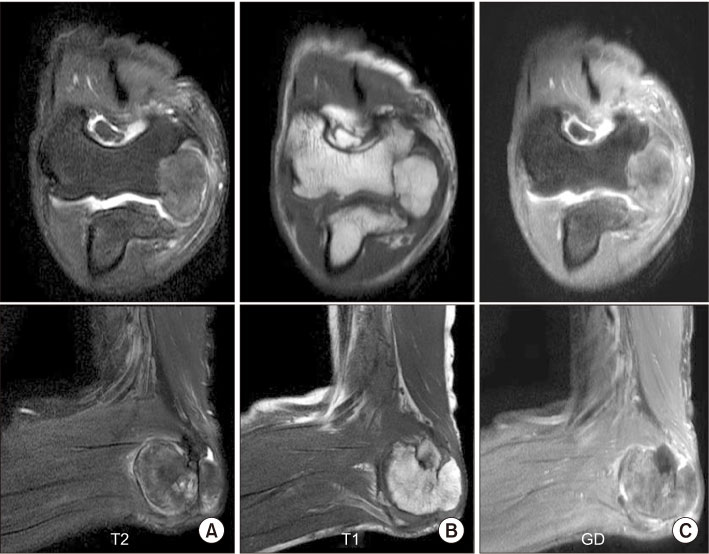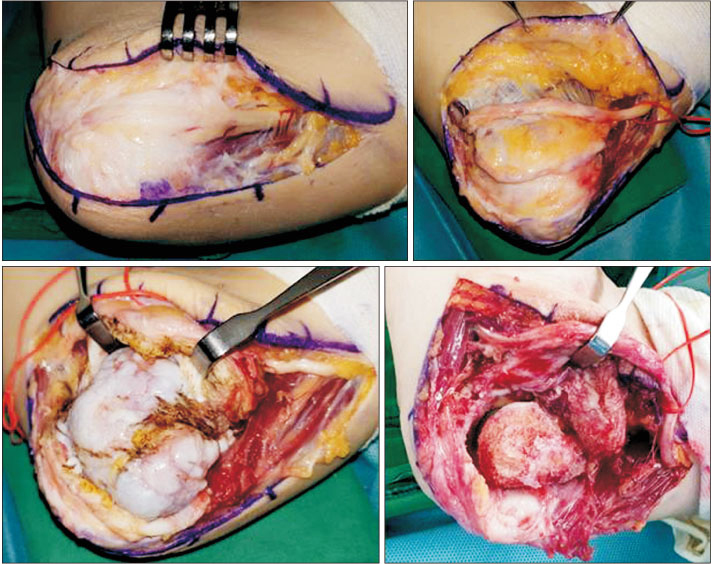Arch Hand Microsurg.
2019 Mar;24(1):96-101. 10.12790/ahm.2019.24.1.96.
Cubital Tunnel Syndrome Caused by Osteochondroma: A Case Report
- Affiliations
-
- 1Department of Orthopedic Surgery, Wonkwang University School of Medicine, Iksan, Korea. kanghongje@hanmail.net
- KMID: 2440618
- DOI: http://doi.org/10.12790/ahm.2019.24.1.96
Abstract
- Cubital tunnel syndrome is a compressive neuropathy caused by ulnar nerve compression on elbow joint. The causes of cubital tunnel syndrome are unknown but it can be caused by trauma, bone deformity and space occupying lesions like a mass. Osteochondroma is a common benign bone tumor, it usually develops at the metaphysis of the long bones. Symptoms of nerve compression by osteochondroma are very rare and there have been few reports of cubital tunnel syndrome caused by osteochondroma. The authors experienced a 46-year-old male patient who have cubital tunnel syndrome by osteochondroma. Therefore, we report the case with literature review.
Keyword
MeSH Terms
Figure
Reference
-
1. Fernandez E, Pallini R, Lauretti L, Scogna A, La Marca F. Neurosurgery of the peripheral nervous system: cubital tunnel syndrome. Surg Neurol. 1998; 50:83–85.2. Heithoff SJ. Cubital tunnel syndrome does not require transposition of the ulnar nerve. J Hand Surg Am. 1999; 24:898–905.
Article3. Kato H, Hirayama T, Minami A, Iwasaki N, Hirachi K. Cubital tunnel syndrome associated with medial elbow Ganglia and osteoarthritis of the elbow. J Bone Joint Surg Am. 2002; 84:1413–1419.
Article4. Herring JA. Benign musculoskeletal tumors. In : Herring JA, Tachdjian MO, editors. Tachdjian's pediatric orthopaedics. 3rd ed. Philadelphia: W. B. Saunders;2002. p. 1901–1953.5. Rizzello G, Franceschi F, Meloni MC, et al. Para-articular osteochondroma of the knee. Arthroscopy. 2007; 23:910.e1–910.e4.
Article6. Szabo RM, Kwak C. Natural history and conservative management of cubital tunnel syndrome. Hand Clin. 2007; 23:311–318. v–vi.
Article7. Lee HJ, Kim JS, Ra IH, Kim PT. Cubital tunnel syndrome caused by ulnar nerve schwannoma - a case report -. J Korean Soc Surg Hand. 2012; 17:191–195.
Article8. Al-Najjim M, Mustafa A, Fenton C, Morapudi S, Waseem M. Giant solitary synovial osteochondromatosis of the elbow causing ulnar nerve neuropathy: a case report and review of literature. J Brachial Plex Peripher Nerve Inj. 2013; 8:1.
Article9. Turan Ilica A, Yasar E, Tuba Sanal H, Duran C, Guvenc I. Sciatic nerve compression due to femoral neck osteochondroma: MDCT and MR findings. Clin Rheumatol. 2008; 27:403–404.
Article10. Demiroğlu M, Özkan K, Kılıç B, Akçal A, Akkaya M, Özkan FÜ. Deep peroneal nerve palsy due to osteochondroma arising from fibular head and proximal lateral tibia. Int J Surg Case Rep. 2017; 31:200–202.
Article
- Full Text Links
- Actions
-
Cited
- CITED
-
- Close
- Share
- Similar articles
-
- Cubital tunnel syndrome caused by an intraneural ganglion cyst treated with epineurectomy: a report of three cases
- Cubital Tunnel Syndrome Caused by Ulnar Nerve Schwannoma: A Case Report
- Cubital Tunnel Syndrome, Associated With Synovial Chondromatosis
- A Case of Cubital Tunnel Syndrome Diagnosed by Ultrasonography in Patient with Normal Electrodiagnostic Studies
- Ulnar neuropathy








